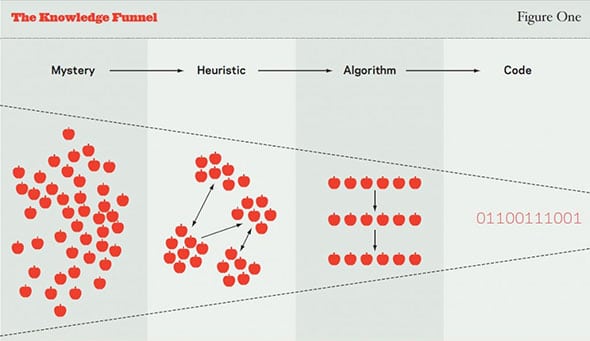Atomic Object has helped many companies design and implement new software products. I’ve noticed different environments at companies that are primed for innovation and companies that are not.
Operational Mindset
Roger Martin’s knowledge funnel concept describes how business practices become more algorithmic as organizations scale and strive for efficiency. As companies scale, their technology departments develop an operational mindset and become more focused on efficiency and stability than on creating opportunity.

(Originally published in Rotman Magazine, Winter 2009.)
Common traits for established technology departments include:
- Technology implementation teams becoming mostly segregated from business stakeholders, designers, product managers, and project managers to reduce communication overhead and increase efficiency of other departments.
- Internal specialization like architecture, web development, database administration, and application development to reduce complexity of hiring, training, and professional development.
- Scheduling people on multiple projects during the same period to increase utilization.
- Identification and enforcement of approved technologies to reduce complexity of infrastructure, hiring, training, and professional development.
- Rigid launch procedures controlled by a separate team to provide a layer of oversight and reduce risk of errors in production.
- Success metrics that focus on minimizing issues instead of creating opportunities.
The previous list makes sense in the context of maintaining the complex operational infrastructure of an established business. In an established company, the value proposition is deep-rooted. Marketing and sales are the drivers of revenue growth, and technology plays a supporting role.
In such environments, technology departments are primarily making incremental modifications or fixing issues with established platforms or infrastructure. Most innovation projects run through such departments are also incremental or evolutionary in nature. Changes to existing platforms and infrastructure must be done with caution so as not to disrupt the offering customers have come to expect.
Innovation Mindset
I’ve noticed that established companies who are committed to innovation recognize that traditional organizational departments aren’t aligned with innovation. Established companies successfully foster innovation by segregating innovation project teams from the rest of the organization and allowing them to play by a different set of rules.
Common traits of technology teams focused on innovation include:
- Members are co-located, cross-functional, and deeply understand their initiative from strategy to implementation details.
- Members are generalists who are eager to learn new skills as necessary and help where needed.
- Members are single-project focused in order to maximize effectiveness.
- Technology choices are flexible and are focused on maximizing product desirability, market competitiveness, and speed.
- Teams have direct control over deployment so they may quickly experiment and improve the product. Infrastructure is segregated from operations to allow for flexibility. Necessary data from operational systems is decoupled through interfaces.
- Success metrics that focus on awareness, conversion, acquisition and retention of customers.
Innovation Management at Established Companies
It’s very exciting to work with established companies that embrace the chemistry for innovation because they have a greater chance of successfully bringing a new product to market.
Existing companies have the benefits of:
- Funding innovation from existing cash.
- Established marketing, sales and distribution channels.
- Established partner and supply chain network.
Big company resources fueling innovation teams that work like startups is a powerful combination.
What pain points and opportunities have you identified while working on an innovation project? What hopes and fears do you have for an upcoming project?

Fabulous, insightful, and profound observations. Thank you!
This reminds me a lot of Michael Lopp’s recent article entitled “Stables and Volatiles” in The Magazine. His approach was less organizational and more on a personal leadership level. He attempts to answer the question: “As a leader within an organization, how does one make room for “volatiles” while helping “stables” to feel safe?”
Thanks for the sharing Michael’s article Jonah. I’ll have to take a peek at The Magazine.
Very thoughtful, Shawn, I liked that quite a lot.
Great article. I agree with the points raised. Instead of using the word ‘mindset’ I’d go further and use ‘management system’ instead. Reason being, GM created this ROI, cost benefit and efficiency management system decades ago and that unfortunately influenced many organizations and management schools. Today’s leaders grew up learning how to manage by objectives which is largely responsible for where knowledge and software organizations are today. Change the management system, change the behaviour of those in the organization. Your ‘mindset’ evolves from your management system and behaviours of your organizational leaders.
Thanks for your comment Jason. I agree that mindset and management systems are tightly intertwined.
Essential to knowing the attitude of IT functions is its focus on providing and keeping “services” that are of value to the world of company.